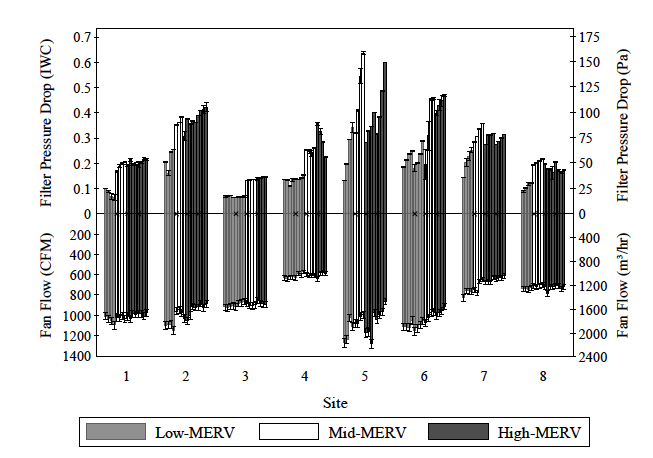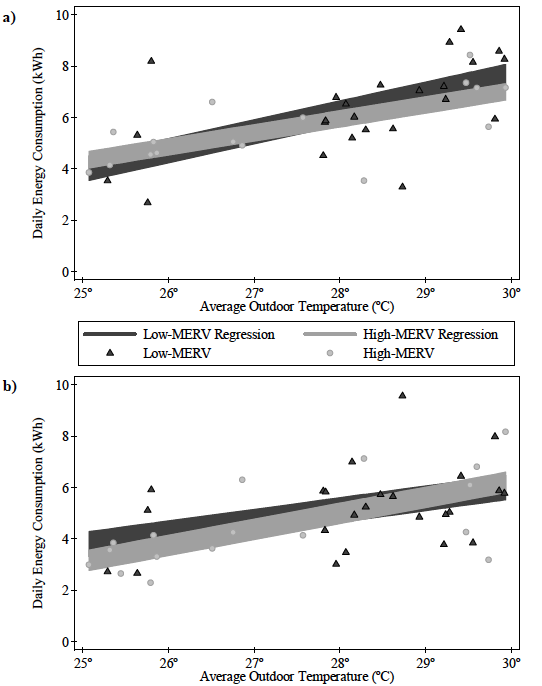Energy implications of HVAC filtration
The use of high-efficiency particle filters in heating, ventilating, and air-conditioning (HVAC) systems is a common strategy to control exposure to particulate matter in buildings. ASHRAE filtration standards provide valuable information to design engineers and building operators about filtration efficiency and pressure drop. Higher-efficiency filters are widely assumed to have significant energy penalties associated with their use because they generally have a higher-pressure drop, but this assumption has been made without adequate experimental evidence. Therefore, this work explored the effects of filters on energy consumption in real residential and light commercial buildings by monitoring 17 forced air HVAC systems in occupied buildings and two controlled test systems in an unoccupied test house on a research campus.
In the first part of this study, we explored the underlying theoretical energy implications of higher-efficiency filters. The airflow and energy consequences of a higher-pressure drop filter in residential or light commercial HVAC systems depend on the pressure drop of the filter relative to the total pressure drop of the return side of the system, the system duct curve, the fan curve, the fan efficiency curve, and the location of the intersection of the fan and duct curves. In general, the underlying theory, in conjunction with data from literature, suggests that the energy effects of higher-efficiency filters in residential systems are likely small, and the magnitude of the effects of high-pressure drop filters on duct leakage, total power draw, and cooling capacity may be positive or negative.
In the field investigation portion of this study, measurements were made once per month for one year at each occupied residential and light commercial system with filters from three different MERV range categories. Measured parameters included system airflow, fan power draw, power draw of the outdoor compressor-condenser unit, cooling capacity, pressure drops across filters and coils, and duct leakage. Higher-efficiency (MERV 11-12) filters generally had a small impact on parameters related to cooling energy consumption in the residential and light commercial test systems when compared to low-efficiency (MERV 2) filters. The median energy consequence of higher-efficiency filtration in the test systems was estimated as a decrease of approximately 16 kWh per ton of nominal capacity (5 kWh per kW of nominal capacity) per month of cooling season operation, albeit with large variation. Most of these small savings came from fan energy reductions. These results suggest that the link between higher-efficiency filters and energy use in smaller residential and light commercial systems is weak and that other factors should govern filter selection.

Airflow rates vs. filter pressure drop with different levels of filter efficiency measured in the 8 residential sites in this study
Similarly, in the controlled test house investigation, we performed detailed energy monitoring in two independent HVAC systems in an unoccupied test home on a research campus for several months. This setting was much more controlled than the field-testing, so we could control for the impacts of climate and thermostat operation. The results from the test house confirm the field-testing findings that the magnitude of potential energy impacts associated with higher-efficiency filters are small. No significant difference in energy consumption due to higher-efficiency filters was observed in the two test systems.

No significant in daily energy consumption with high- and low-MERV filters in two HVAC systems in a test house
Read the full paper of the large field study published in ASHRAE Transactions here. Read the full paper of the test house investigation published in HVAC&R Research here.
Acknowledgements
This work was performed by Brent Stephens while he was a masters student under the supervision of Dr. Jeffrey Siegel at the University of Texas at Austin. Brent’s contribution was funded by the American Society of Heating, Refrigerating and Air-Conditioning Engineers (ASHRAE) as part of research project RP-1299. We thank Federico Noris, who assisted in the collection of these data, as well as members of the project monitoring subcommittee within ASHRAE.
